the Creative Commons Attribution 4.0 License.
the Creative Commons Attribution 4.0 License.
Forecasting agricultural drought: the Australian Agricultural Drought Indicators
Andrew Schepen
Andrew Bolt
Dorine Bruget
John Carter
Donald Gaydon
Mihir Gupta
Zvi Hochman
Neal Hughes
Chris Sharman
Peter Tan
Peter Taylor
Drought is a recurrent and significant driver of stress on agricultural enterprises in Australia. Historically, rainfall indices have been used to identify drought and inform government responses. However, rainfall indicators may not fully reflect agricultural or economic drought conditions and are a lagging indicator. To address these shortcomings, the AADI (Australian Agricultural Drought Indicators) was recently developed to monitor and forecast drought for upcoming seasons using biophysical and agro-economic models, including crop yields, pasture growth and farm profit, at ∼ 5 km2 resolution. Here, we evaluate the skill of drought indicator forecasts driven by the ACCESS-S2 dynamical global climate model over a hindcast period from 1990–2018. Analysis of the AADI hindcasts finds that antecedent landscape conditions significantly enhance predictive skill for crop yields, pasture growth and farm profit across a financial year. As lead time shortens from 12 to 3 months, forecast confidence increases: median farm profit skill rises from 43 % at 12 months to 67 % and 73 % at 6 and 3 months, respectively, whilst median farm profit biases remain below 2 % across all lead times, with high reliability indicating a well-calibrated ensemble, making the forecasts highly suitable for risk management and decision-making. Forecasts for wheat, sorghum, and pasture are also skilful and reliable in ensemble spread, although residual biases can occur (e.g. up to 20 % for sorghum) and suggests further system refinements are needed. Analysis of historical events under both dry and wet conditions demonstrated the AADI system's ability to identify drought-impacted areas with increased confidence up to 6 months earlier than rainfall deficits.
- Article
(7585 KB) - Full-text XML
- BibTeX
- EndNote
Drought is a recurrent and significant challenge in Australia and affects water resources, agriculture and ecosystems (Van Dijk et al., 2013; Devanand et al., 2024; Holgate et al., 2020; Lindesay, 2005). Two major droughts in recent decades are the Tinderbox Drought (2017–2020) and the Millennium Drought (2001–2009), which both had major impacts on industry and the environment. Even outside of drought periods, industries such as cropping and livestock are exposed to risks from high seasonal climate variability, long-term declines in cool season rainfall (Mckay et al., 2023) and/or decadal monsoon variability (Heidemann et al., 2023). Historically, government responses to drought impacts in the agriculture sector have been informed by meteorological drought indicators such as rainfall deficits. However, it is understood that rainfall indicators are often flawed proxies for agricultural and economic drought impacts (Hughes et al., 2022a; Das et al., 2023; Stagge et al., 2015; Wang et al., 2022). In the absence of accurate assessments of agricultural impacts, government drought responses can be poorly directed and overly reactive to media narratives (Rutledge-Prior and Beggs, 2021). Addressing these challenges requires not only monitoring of drought conditions but also forecasting of drought onset and recovery (Das et al., 2023; Stagge et al., 2015; Wang et al., 2022).
Whilst many drought warning systems have been developed globally, most focus on meteorological indicators and emphasise monitoring over forecasting (Van Ginkel and Biradar, 2021). In Australia, tools like the AussieGRASS model (Carter et al., 2000) have long provided forecasts of agricultural indicators like pasture growth using analogues selected according to the Southern Oscillation phase (https://www.longpaddock.qld.gov.au/aussiegrass/, last access: 20 June 2025). In recent work, Bhardwaj et al. (2023) combined rainfall, soil moisture and evapotranspiration into a principal component analysis (PCA) index, which they then paired with seasonal rainfall forecasts to develop a drought concern matrix. For example, dry antecedent conditions coupled with a high likelihood of low rainfall correspond to the highest level of drought concern. Whilst Bhardwaj et al. (2023) demonstrated the use of seasonal forecasts in a drought early warning system, more work is needed to understand the regional economic impacts of agricultural drought across the combined cropping and grazing sectors, particularly as drought impacts can be modulated by external factors such as commodity prices.
The Australian Bureau of Agricultural and Resource Economics and Sciences (ABARES) has developed a statistical farm microsimulation model – farmpredict – which integrates climate data and farm survey data to predict consolidated farm profit for a region (Hughes et al., 2019, 2022b). An example of farmpredict output is provided in Fig. 1, which shows the expected relative farm profit for the financial year 2018–2019, where the negative impact of the Tinderbox Drought (Devanand et al., 2024) on farm profits can be seen over south-eastern Australia. The question arises, then, whether farmpredict can be successfully driven by climate forecast ensembles to generate skilful forecasts of financial outcomes for farm businesses.
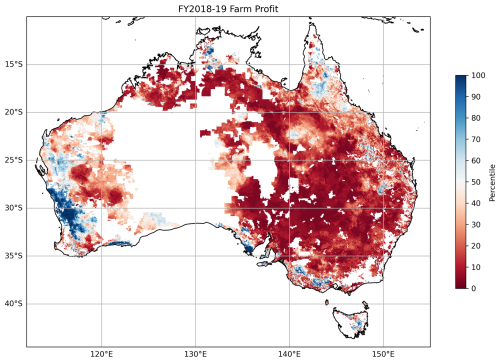
Figure 1Percentiles of farm profit for the 2018–2019 financial year as output by the farmpredict model using a 1990–2018 baseline. The shaded regions are agricultural land and constitute the study area.
Such an approach is not without precedent, as climate forecast ensembles have been used to generate seasonal outlooks of crop yields (e.g. Potgieter et al., 2022; Schepen et al., 2020a). Indeed, in addition to farm profit outlooks, drought analysts and policy planners can also be interested in the potential yield outlooks for winter and summer crops or pasture availability for livestock.
Here, we connect climate forecasts from the Bureau of Meteorology's ACCESS-S2 seasonal model to farmpredict, crop models and a pasture model, considering only rainfed systems. Initially, climate forecast post-processing is needed to develop forecast ensembles that have the same characteristics as the observations used in the downstream models. New drought indicator forecasts are generated by forcing the downstream models with the post-processed climate ensembles on a 5 km grid across Australia. Corresponding pseudo-observations of the target variables, which we call historical simulations, are generated by forcing the same models with observational weather data.
In this study, we assess the forecast performance of four agriculturally focused drought indicators – pasture growth, wheat yield (representing winter crops), sorghum yield (representing summer crops) and farm profit – that form the AADI (Australian Agricultural Drought Indicators) system (Hughes et al., 2025). Often, drought system performance is evaluated using threshold or categorical forecasts (e.g. bottom tercile) (Madrigal et al., 2018; Sutanto et al., 2020; Li et al., 2023). Here, we verify forecasts using ensemble verification metrics and an ensemble of 51 members, which allows assessment across the range of thresholds and performance for non-drought years as well as drought years. Forecast performance is investigated in terms of bias, accuracy (using the continuous ranked probability score), reliability (using probability integral transforms) and sharpness (using the interdecile range, IDR). Additionally, we analyse the evolution of forecasts for major historical events.
The paper is subsequently organised as follows. Sections 2 and 3 present the data and methods, including a summary of the climate, biophysical and farmpredict models, climate forecast downscaling, cross-validation, and forecast verification. In Sects. 4 and 5, the results are presented and discussed, respectively. Section 6 concludes the paper with the main findings. It is anticipated that the results of this study will support the operational AADI system by providing drought analysts with a level of confidence in the forecasts dependent on location, lead time and indicator, as well as by serving as a demonstration of a novel agricultural drought forecasting system driven by climate ensemble forecasts.
2.1 SILO gridded climate data
SILO is a gridded dataset of climate data, mostly constructed from real measurements, that is used as the observational data. It is interpolated and infilled to give continuous coverage across Australia at 5 km resolution (Jeffrey et al., 2001), which makes it highly suitable for large simulation studies. In addition, it is already integrated with the AussieGRASS and APSIM (Agricultural Production Systems sIMulator) simulation systems. SILO is an operational product of the Queensland Government and is therefore continuously monitored and updated for quality.
The complete set of target variables required for the biophysical and economic models are minimum and maximum temperature (Tmin and Tmax), rainfall (Rain), incoming solar radiation (Radn), synthetic pan evaporation (Evap), and vapour pressure (Vapr). SILO data are aggregated in several ways for the purposes of climate forecast downscaling; more details are provided in Sect. 3.1.
2.2 ACCESS-S2 climate model
Climate forecasts are sourced from ACCESS-S2, a global dynamical climate model from the Australian Bureau of Meteorology that provides forecast ensembles up to 6 months ahead. ACCESS-S2 is selected as the model for real-time forecasting due to daily updates supporting timely forecast release. For this retrospective testing, raw hindcasts of ACCESS-S2 (Wedd et al., 2022) are available for initialisation dates between 1 January 1981 and 31 December 2018. We make use of ensemble members generated on the 1st of each month as well as the preceding 8 d, which gives a raw ensemble comprising 27 members. Because the lag times are relatively short, the members are assumed to be exchangeable, which means they are treated as random draws from the same underlying distribution.
The climate variables used in the calculation of predictors are daily rainfall (pr), minimum temperature in 24 h (tasmin), maximum temperature in 24 h (tasmax), net incoming shortwave solar radiation (rsds), specific humidity (huss), pressure (ps) and sea surface temperature (sst).
ACCESS-S2 raw data are on an approximate 80 km × 60 km grid. Each run is initialised at midnight UTC, and forecast variables are provided at a daily time step up to 215 d ahead. For the purposes of statistical forecast post-processing, we aggregate the forecasts to a monthly time step.
2.3 The AADI system
The AADI system links biophysical and agro-economic models driven by weather observations and forecasts (Fig. 2). As this study focuses on the hindcasting performance, we refer to Hughes et al. (2025) for details on the configuration of APSIM, AussieGRASS and farmpredict. However, for completeness, we give a summary of the critical details here and describe the key datasets in Table 1.
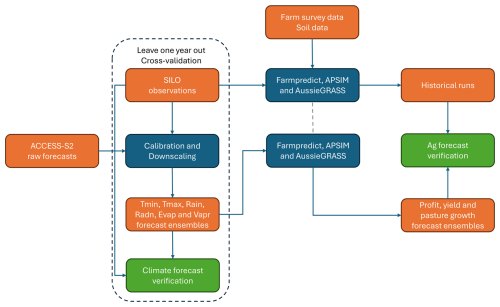
Figure 2Schematic of the workflows for (1) generating and verifying climate forecasts under leave-1-year-out cross-validation and (2) subsequently generating and verifying profit, yield and pasture growth forecasts.
Table 1Key datasets used for AADI forecast verification, description of their purpose, spatial resolution and time periods.
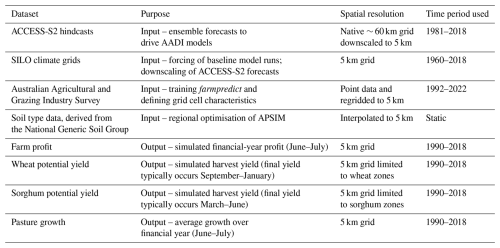
APSIM simulates potential crop yield under different climatic conditions. For each hindcast year, APSIM is initialised with 15 years of historical weather data to establish equilibrium conditions, then run forward with SILO observations or ACCESS-S2 forecasts. Wheat simulations use cultivars optimised for yield in each grid cell, with specific management rules for sowing and fertilisation tailored to three regional zones. Sowing typically occurs between April and July, with nitrogen applied based on soil deficits and crop growth stages. Sorghum uses the “Buster” variety with optimised density. Currently, AADI produces water-limited yield, which represents the yield that can be achieved using current best practices, technology and genetics for rainfed crops.
AussieGRASS, a pasture growth model operational for over 25 years, simulates pasture dynamics on a 5 km grid across Australia. Unlike other models that operate on a point-based system, AussieGRASS uses highly optimised code to run daily simulations across all grid cells, integrating tightly with SILO weather data. This model supports drought assessment and forecasting, providing insights into pasture availability under varying climatic conditions.
Farmpredict uses a statistical micro-simulation approach to model Australian broadacre farms, leveraging Australian Agricultural and Grazing Industry Survey (AAGIS) data and machine learning (xgboost). It links farm characteristics, climate and commodity prices to predict farm outputs and financial outcomes, including profit (July to June financial years). For example, farmpredict increases Australian fodder price and widens the Australian grain price basis (relative to global prices) when drought occurs. Trained on 45 000 AAGIS observations from 1991–2022, farmpredict integrates geocoded farm data with SILO historical climate data to produce simulations of farm performance under different climatic and economic scenarios.
The workflow for generating and verifying the AADI forecasts is shown in Fig. 2. The next sections describe the various components in detail.
3.1 Climate forecast post-processing
Climate forecast post-processing (calibration and downscaling) is required to reduce forecast biases, downscale to local features, extend forecast lead time and improve forecast reliability in ensemble spread. In a sense, post-processing the climate forecasts can be thought of as “pre-processing” for the purposes of agricultural simulations. However, we retain the term post-processing here as it is the usual term for such statistical methods.
We apply the Bayesian joint probability (BJP) modelling approach (Wang et al., 2019; Wang et al., 2009) coupled with an empirical downscaling technique (Potgieter et al., 2022; Schepen et al., 2020b, a). BJP is applied to calibrate climate forecasts on the coarse ACCESS-S2 grid. Then, the method of fragments (MOF; e.g. Westra et al., 2012) is applied to disaggregate forecasts to 5 km spatial resolution and to a daily time step, as described by Schepen et al. (2020b), who extended the MOF to disaggregate multiple variables simultaneously.
BJP applies transformed bivariate normal distributions to model the relationship between the predictor variables, which are taken as the means of the raw ACCESS-S2 ensembles, and observed variables, which are taken as the corresponding SILO observations. A transformation step accounts for non-normality, and non-continuous variables are handled through censoring in both the transformation and BJP models (Wang and Robertson, 2011; Wang et al., 2019). By conditioning the joint distribution on new values of the raw forecasts, a calibrated forecast distribution is obtained, from which a representative ensemble can be sampled. We sample 51 ensemble members. An advantage of the BJP calibration, by virtue of being a model output statistics (MOS) approach, over simple bias corrections (such as linear scaling or quantile mapping) is that it returns the forecast to a climatology when the relationship between raw forecasts and observations is weak. In other words, it harnesses skill where available and returns a baseline forecast otherwise.
Raw versions of the target variables vapour pressure and evaporation are not directly available from ACCESS-S2; however, we can approximate them from the available outputs using the following standard equations:
where q is the specific humidity (kg kg−1), and Ps is the surface pressure (Pa),
where TA is the average surface temperature (°C), and Rs is the surface solar radiation (MJ m−2).
The main reason BJP is applied to monthly, coarse-resolution forecasts is to calibrate forecasts at the scales of seasonal signals and because calibration at a high spatial resolution and daily time steps is computationally expensive. However, efficient spatial and temporal downscaling is then necessary. MOF is efficient but relies on having daily observational datasets at the target resolution, which we have. In MOF, each BJP post-processed forecast ensemble member is matched to aggregated historical observations through a nearest-neighbour search (Schepen et al., 2020b). The pattern of observations within the month and at each high-resolution grid cell is used to simultaneously disaggregate the forecast, which generates sequences with the correct intervariable, spatial and temporal correlations. Finally, the Schaake Shuffle (Clark et al., 2004) is applied to every 5 km grid cell to link the ensemble members in grid cells across the continent to generate a national-scale forecast grid with correct spatial, temporal and intervariable dependencies.
In addition to calibrating the ACCESS-S2 forecasts, the forecast ensembles are extended up to 18 months ahead to allow the biophysical and economic models to be run over multiple financial years. Forecast augmentation occurs by introducing a “no-input” BJP model for lead times beyond 6 months. The no-input models effectively model the marginal distributions of the climate variables, and the outputs can therefore be seamlessly blended with the calibrated forecasts by disaggregating and shuffling in the same way as the forecast ensemble members. In effect, the post-processed forecasts comprise 6 months of ACCESS-S2-based forecasts extended up to 18 months using model-generated climatology.
3.2 Forecast verification
The AADI system produces raw outputs in the form of ensemble forecasts. It is therefore possible to assess the forecasts using ensemble forecast verification methods, which is the primary way we assess forecast skill. The important aspects of forecasts to be verified include accuracy, bias and reliability. We also assess forecast sharpness for additional context around these metrics.
Verification of climate forecast post-processing is undertaken via a leave-1-year-out cross-validation framework. Whilst not able to completely eliminate bias associated with training and evaluating over the same period (Risbey et al., 2021), cross-validation is a means to obtain a realistic skill estimate when there are insufficient data for split-sample testing and remains standard practice in seasonal forecasting.
Model-based agricultural forecasts are verified via comparison with the pseudo-observations (i.e. ignoring model error). As such, the results offer an assessment of climate forecast skill in a specific agricultural context but do not estimate the absolute skill of these models in forecasting on-the-ground agricultural outcomes (crop yields, pasture growth or farm profits). The related study of Hughes et al. (2025) offers a detailed assessment of AADI performance against a range of observed ground truth data, while skill assessments of the individual models have been published previously (for example, Hughes et al., 2022b, present leave-1-year-out cross-validation results for farmpredict).
3.2.1 Ensemble scores
Percentage bias is calculated to assess systematic over- or underprediction:
where is the forecast ensemble mean for event t, and ot is the corresponding observation.
The continuous ranked probability score (CRPS) is a metric for evaluating the accuracy of an ensemble forecast considering the full distribution of the forecast:
where Ft is the cumulative distribution function representing the forecast ensemble for event t, and is an indicator function representing the cumulative distribution function (CDF) of the observation, which is 1 for x≥ot and 0 otherwise. We adopt the empirical calculation of CRPS as per Hersbach (2000).
The average CRPS over a set of forecasts is compared to a baseline or reference set of forecasts and computed into a skill score that quantifies the percentage reduction in error:
The skill score can reach a maximum of 100 %, which indicates a perfect match between forecasts and observations. A skill score of 0 % indicates that the forecasts and reference forecasts have similar overall performance. Negative skill scores are unbounded but indicate that the forecasts do not add value over knowledge of the historical (climatology) distribution.
Reliability is assessed through evaluation of the distribution of probability integral transforms (PITs):
If the frequency of observations is consistent with forecast probabilities, then the PIT values over a set of events will be uniformly distributed (Diebold et al., 1998), which can be assessed using a standard uniform QQ plot (e.g. Wang and Robertson, 2011). The mean absolute deviation of the PITs from the 1:1 line can be summarised into an overall reliability (REL) metric:
where PIT(i) is the ith-ranked PIT value in ascending order, and the score has been adjusted to range between 0 and 1, where 1 is perfect reliability, and 0 is poor reliability.
In a properly calibrated ensemble forecasting system, forecast sharpness and forecast skill will be related. However, to aid in the interpretation of reliability with respect to bias and forecast sharpness, we consider the relative width of the forecast ensemble interdecile range (IDR) over the climatological IDR as a measure of forecast ensemble spread (dispersion). If dispersion is 100 %, then, on average, the forecast ensembles are the same width as the climatology. Typically, it is expected that the forecast ensemble spread narrows with increasing skill.
where and are the inverse CDFs of the forecast and reference forecast, respectively.
3.2.2 Reference forecasts
A reference ensemble for assessing forecast skill is created by using the set of historical observations. In the leave-1-year-out cross-validation framework, a separate reference ensemble is assembled for each target year by omitting the observation for the target year and using the observations from all the other years to construct the ensemble. The reference ensemble is not influenced by the present year's antecedent conditions nor the climate forecast and therefore sets the baseline for skill as knowledge of the historical spread of grain yields, pasture growth or farm profits. Whilst other baselines are possible, the use of these historical simulations as a reference is consistent with the construction of the indicators, which are expressed as percentiles of the historical simulations.
3.2.3 Spatial and temporal sampling
AADI is set up in real-time on a 5 km grid and runs every month. However, the computational and financial cost of running APSIM in all grid cells is prohibitive in the current technological environment. Therefore, for the wheat and sorghum simulations, we sample every fourth grid cell, which, as can be seen in the results, gives considerable coverage. The AussieGRASS and farmpredict models retain full coverage. We also evaluate performance only four times in the year, for forecasts beginning in April, July, October and January, which were selected to roughly align with agricultural industry decision points.
4.1 Climate
We briefly present the skill of climate forecasts to analyse the contribution of climate to the overall skill of the drought indicators. The CRPS skill scores of the calibrated monthly climate forcings are summarised in Fig. 3. Each doughnut plot shows the median and interdecile range of skill for a climate variable at a lead time for each forecast issue month. The percentiles are determined by pooling all grid cells and therefore indicate spatial coverage. At 1 month's lead time, most of the climate forecasts have moderate skill, with temperature, evaporation and vapour pressure being the mostly skilfully predicted variables. Radiation and rainfall have relatively low skill. Beyond 1 month's lead time, low to moderate skill is evident in the 90th percentiles for temperature, evaporation and vapour pressure, indicating skill in some regions in the austral spring. Elsewhere, and at lead times beyond 2 months, skill is minimal. Slightly negative skill scores are evident, albeit expected in cross-validation.
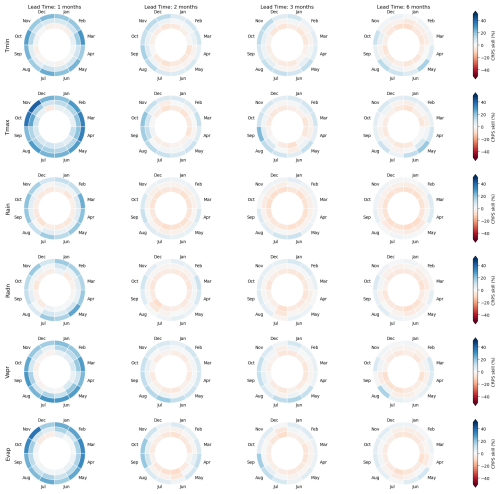
Figure 3Summary of CRPS skill scores of the climate forecasts over the climate hindcast period 1981–2018. The three rings depict the median (middle ring) and interdecile range (inner ring = 10th percentile; outer ring = 90th percentile). Each ring segment represents a forecast issue month from January to December in a clockwise direction. Target climate variables are in rows, and the lead times (months ahead) are in columns.
Bias and reliability have also been evaluated and have been omitted for brevity given previous reporting and almost universal high reliability (PIT reliability scores > 0.8) and minimal bias (typically within ±5 %). However, some locations show a moderate percentage bias (20 %) for rainfall in the dry season, where low seasonal totals magnify relative errors, and the prevalence of zeros makes it more difficult to perfectly correct mean bias due to lower-bound effects.
4.2 Farm profit
Maps of bias, reliability, dispersion and overall skill for the farm profit indicator are presented in Fig. 4 for each of the forecast issue months. The farm profit indicator displays little or no bias (within ±5 %) for forecasts issued in April, January and October of the current financial year (FY). However, regions of positive bias exist in the central east for forecasts issued in July of the current FY and April of the previous FY (up to 20 %). Skill increases markedly as the end of the financial year approaches, which is mainly due to an increasing proportion of observed data being integrated into the indicator. Even so, for July-issued forecasts, which have a lead time of 12 months, the median CRPS skill score is 45 % (23 %–64 % IDR). This level of skill is quite high when contrasted with the skill of climate forecasts, which typically have CRPS skill scores of less than 30 %, depending on the location and season, and typically not more than a few months ahead (see discussion in Sect. 5). We can infer that the high degree of skill in the farm profit indicator is primarily due to knowledge of the antecedent environmental and economic conditions rather than climate. Skill improves markedly as lead time decreases, and for April forecasts of the current FY, skill reaches approximately 80 %–90 %, which suggests that predicted farm profits converge with many months' lead time.
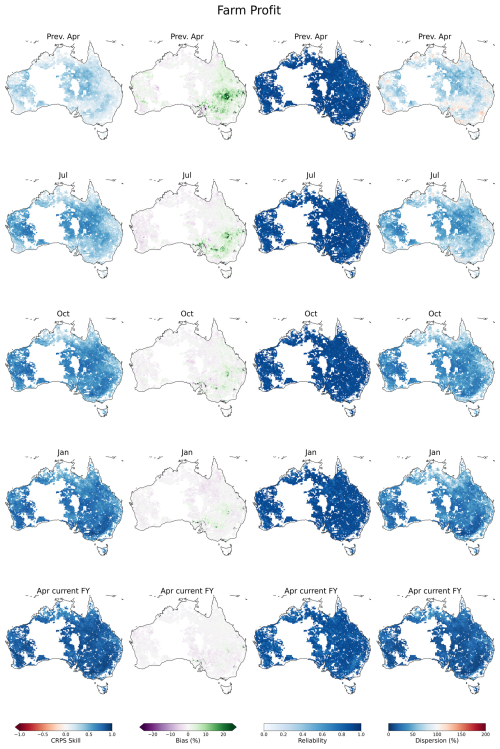
Figure 4Forecast verification maps for the farm profit indicator calculated over the period 1990–2018. Columns are per verification metric: CRPS skill score, bias, reliability and dispersion. Rows are per forecast issue date: April in the previous financial year, then July, October, January and April of the current financial year.
For each forecast issue month, the skill of farm profit predictions shows limited spatial variation, suggesting that forecast errors are relatively consistent across different climatic and agricultural zones. Reliability is high (> 0.8) for all forecast issue months and regions. High reliability indicates that the forecast probabilities are consistent with the frequency of outcomes, and, therefore, the ensemble spread is typically unbiased and of appropriate spread. The relative width of the forecasts is also measured through dispersion, showing that, compared to the historical distribution of profits, the forecast ensemble spreads tend to be about as wide as the historical distribution at long lead times. As forecast skill improves, the spreads narrow in concert with the increase in skill, suggesting that the economic forecasts remain well calibrated. Moreover, in cropping regions, dispersion is lower in January and April compared to (say) northern regions, with a differentiation between completed crops and pasture-dominant areas, consistent with farm profits in the winter cropping zone being highly dependent on April-to-October rainfall.
4.3 Winter crops (wheat)
In Australia's warmer northern regions, wheat is typically sown from May to July and harvested from October to December, while in cooler southern regions, sowing occurs from April to June, with harvests from November to January, although there can be variation outside these windows. The verification metrics for April forecast issue dates of the previous FY and July, October and January forecast issue dates of the current FY are mapped in Fig. 5. January is the latest forecast issue date because the crops are harvested by this time. Skill tends to be low for wheat around sowing time and, as to be expected, increases gradually as the season progresses. For forecasts issued in July, the median CRPS skill score is 31 % (14 %–56 % IDR), which indicates moderate association with historical simulations with 3–6 months' lead time. By flowering and harvesting, skill is typically very high (80 %–90 %), indicating that the forecasts have converged and match the historical simulations well. Biases overall are small (within ±5 %), except for the April-issued forecasts, where positive biases appear in central Queensland, and negative biases appear in south-western Western Australia. Reliability is high for forecasts issued in April, July and October. Reliability appears to decrease for January-issued forecasts; however, this is somewhat misleading because the maturation of the crops means the ensemble spreads are correspondingly very narrow (as indicated by dispersion). Consequently, it is possible for the observation to fall marginally outside the ensemble, leading to poor probabilistic reliability, despite having a small absolute error.
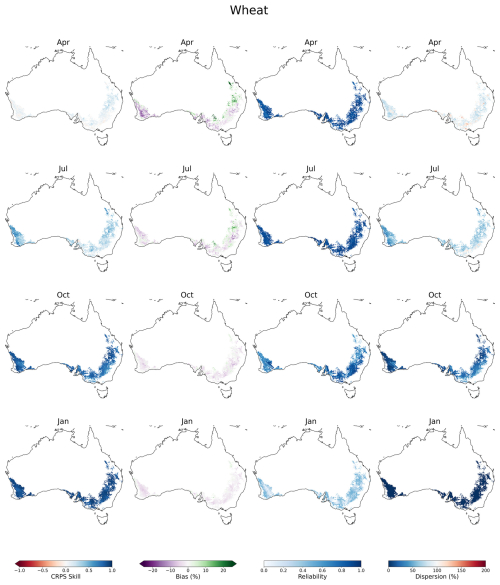
Figure 5Forecast verification maps for the APSIM potential wheat yield indicator calculated over the period 1990–2018. Columns are per verification metric: CRPS skill score, bias, reliability and dispersion. Rows are per forecast issue date: April in the previous financial year, then July, October and January of the current financial year.
4.4 Summer crops (Sorghum)
Sorghum crops are limited to regions in Queensland and New South Wales, often sown as an opportunistic crop in between regular wheat planting. Sorghum has a wide window of sowing opportunity from September to January, with the crop cycle taking 4–5 months to complete.
The assessment of sorghum hindcasting skill is presented in Fig. 6. Overall skill, in terms of the CRPS skill score, is only evident after crop emergence, that is for forecast issue dates in January and April. The median skill for forecasts issued in January is 31 % (13 %–41 % IDR), and median skill for forecasts issued in April is 51 % (29 %–68 % IDR), indicating low to moderate forecasting skill. A mixture of positive and negative bias is evident across all forecast issue dates; the median absolute magnitude of the percentage bias for the forecast issue months ranges from 6.2 % to 7.7 %, suggesting a discrepancy has arisen between the historical simulations (pseudo-observations) and the hindcast simulations (see Sect. 5 for further discussion). As with the wheat hindcast results, the sorghum simulations demonstrate high reliability, except for the April-issued forecasts, for which reliability is artificially deflated by the very narrow spread of a grown crop.
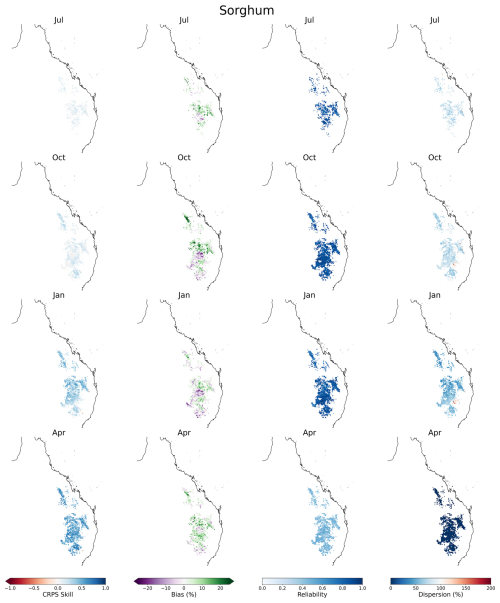
Figure 6Forecast verification maps for the APSIM potential sorghum yield indicator calculated over the period 1990–2018. Columns are per verification metric: CRPS skill score, bias, reliability and dispersion. Rows are per forecast issue date: July, October, January and April of the current financial year.
4.5 Pasture growth
Pasture growth includes native, rainfall-driven pastures, improved pastures and cropping systems, making the interpretation of the simulations more complex. To make the interpretation of the pasture growth more similar to the other indicators, pasture growth over a financial year is the combination of historically simulated pasture growth up until the forecast issue date and the aggregation of pasture growth over the remaining months of the forecast year.
Compared to the cropping simulations, pasture simulations have larger biases, particularly in central and western Australia, and skill is overall lower (Fig. 7). For July-issued forecasts, the 12-month outlook has a median CRPS skill score of 13 % (0 %–28 % IDR) and the median CRPS skill for April-issued forecasts, essentially a 3-month outlook on top of the 9-month accumulated growth, is 75 % (56 %–86 % IDR). Reliability is typically high across all forecast issue months, with median reliability being approximately 0.9.
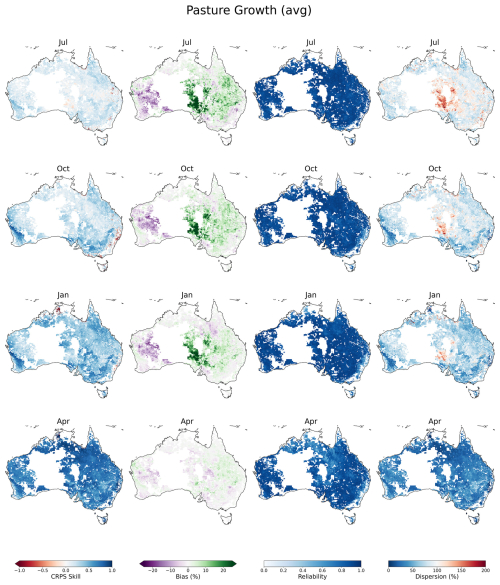
Figure 7Forecast verification maps for the AussieGRASS pasture growth indicator calculated over the period 1990–2018. Columns are per verification metric: CRPS skill score, bias, reliability and dispersion. Rows are per forecast issue date: April in the previous financial year, then July, October and January of the current financial year.
4.6 Historical events
To analyse how the retrospective forecasts evolve over time at a national scale, the percentiles of spatially averaged farm profit are plotted against the forecast issue month for each hindcast year, along with the final farm profit and, as a reference indicator, percentiles of 12-month observed rainfall deficits. All grid cells are weighted equally in the averaging. Although the rainfall deficit percentiles do not directly correspond to final farm profit, their evolution can offer insights into how such a lagging indicator, currently used for drought assessments, behaves in comparison with the forecast indicator.
We select a small number of the “worst” years for agriculture for detailed analysis based on the final farm profit percentile. The 4 worst years, from lowest to highest percentile, are 2003, 2007, 2019 and 1995. For balance, we also briefly consider the “good” years, all of which are visible in Fig. 8.
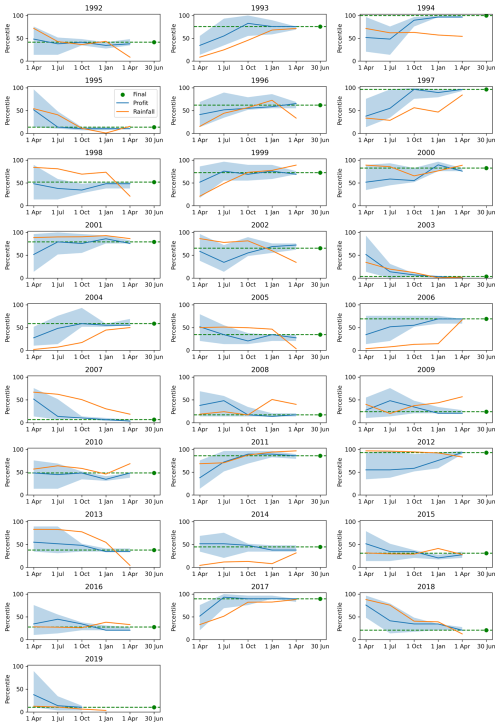
Figure 8Time series plots of the nationally averaged farm profit indicator within agricultural zones (blue line), with the blue shading depicting the interdecile range of the ensemble. The x axis depicts the forecast issue date, and the y axis is the percentile. The final farm profit for the financial year is plotted (green line) as well as the nationally averaged 12-month-lagged rainfall percentile (orange line).
Working in chronological order, the 1995 farm profits were affected by a drought built on back-to-back El Niño events in 1993/1994 and 1994/1995, with rainfall deficits most severe in the second half of 1994, before the drought broke in January 1995 (White et al., 1998; Lindesay, 2005). At 12 months' lead time (July-issued forecasts), the rainfall and farm profit indicators both indicate below-average conditions, although the farm profit indicator provides earlier warning that the impacts are likely to be more severe. By 9 months' lead time (October-issued forecasts), the rainfall and farm profit indicators are both pointing to a severely impacted year.
The 2003 drought, the worst in terms of farm business outcomes, occurred in the middle of the Millennium Drought. Long-term rainfall deficits began dipping below normal in 2002 in response to low rainfall across most of the continent (Fig. 8). The severity of the drought may have been somewhat surprising at the time given the weak to moderate level of the associated El Niño event (Mcphaden, 2004; Wang and Hendon, 2007), which highlights that a single climate driver cannot be relied upon as a signal of drought, and the antecedent conditions, such as existing hydrological drought, play a significant role. At 12 months' lead time (July forecast issue), the farm profit and rainfall indicators both point to well below-average conditions. As the year progresses, both indicators continue to trend downwards, indicating that, in this case, the progression of meteorological drought was locked fairly in sync with the weakening outlook for farm profits.
After a brief reprieve, the 2007 farm profits were also impacted by the Millennium Drought and associated with the development of a weak El Niño event (e.g. Su et al., 2018). With 12 months' lead time, the farm profit indicator indicated a high likelihood of low profits. However, the 12-month rainfall indicator showed relatively normal rainfalls. In the following months, the rainfall indicator trends from slightly above average to slightly below average, whilst the farm profit indicator remains low. The reason for the rainfall indicator failing to drop low is that rainfalls in western Australia were above average, whilst meteorological drought conditions mainly intensified in the south-east. Consideration of localised information is therefore critical in the use of indicators from a drought early-warning system.
The final drought year analysed sits within the Tinderbox Drought, which peaked in terms of farm profits impacted in 2019. It is only possible to analyse the first three forecasts for this event because the retrospective forecasts from ACCESS-S2 finish in 2018. We can see that in 2019, both the rainfall and profit indicators are indicating severe drought impacts, with up to 12 months' lead time. The 2018–2019 drought rapidly transitioned to severe drought conditions following on from an exceptionally wet period in 2016–2017. In fact, the evolution of the drought indices through 2017 to 2019 shows that the farm profit indicator provided advanced indications of high farm profit with 12 months' lead time in 2017 before leading the rainfall indicator into drought conditions in 2018.
Whilst the focus in this study is on drought, the performance of the drought indicators in normal and “good” years is also relevant, for example, in the context of false alarms. We can summarise that in 1994, 1997 and 2017, the farm profit indicator provided advance information for high farm profits compared to the rainfall indicator; however, for 2012, rainfall remained high following the 2010–2011 high rainfall, and the farm profit indicator was relatively late in identifying high profits, partially because the profit indicator “resets” at the beginning of the financial years, whereas the rainfall indicator is continuous.
Climate forecast post-processing is an essential step to preparing raw climate forecast ensembles from a dynamical climate model for ingestion into the downstream biophysical and agro-economic models. Climate forecast skill is generally available for 1 month ahead across a set of climate variables (temperature, rainfall, radiation, evaporation and vapour pressure), with widespread CRPS skill scores up to 30 % (Fig. 3). Beyond the first month, limited skill is available in temperature, vapour pressure and evaporation forecasts, with little or no skill in rainfall and radiation forecasts. However, because calibrated climate forecasts have little or no bias (except rainfall forecasts in dry regions can show moderate percentage bias) and high reliability in ensemble spread, the forecasts provide suitable forcings for the downstream models even where skill is limited. While we have not tested raw forecasts or simple bias correction of climate forecasts, formal calibration ensures that forecast ensembles resemble SILO observations, which is vital for maintaining spatial, temporal and intervariable characteristics between forecasts and baselines.
Our results demonstrate much higher skill for the drought indicators compared to climate, which highlights the predictive importance of antecedent environmental and economic conditions in the downstream models. The AADI models are integrative and capture not only rainfall, but important factors like antecedent soil moisture and prices over the preceding months and years. The narrower ensemble spreads afforded by skilful forecasts provide drought policy analysts greater confidence in identifying areas requiring greater attention. Forecasts of all drought indicators show high reliability in ensemble spread, which supports their use for probabilistic decision making at an appropriate risk level.
Some moderate biases exist in farm profit, sorghum and pasture in central–eastern parts of Australia. Sometimes, such as with farm profit, these vanish at shorter lead times. Such discrepancies between historical runs and hindcast simulations, especially evidenced by bias in hindcasts after convergence is expected (e.g. Fig. 6), highlight potential differences in configuration or input data when historical simulations and hindcasts were run on different computing infrastructure. In contrast, the wheat indicator is largely bias-free across all lead times. Future work will focus on running all simulations on the same infrastructure to ensure consistency across both datasets to improve the reliability of the predictions and minimise bias.
Although month-to-month pasture results are not shown, they exhibit larger forecast biases compared to seasonal or annual averages. In AussieGRASS, the parameterisation related to the soil water index, which controls plant growth onset and cessation, contributes to non-linear responses to rainfall. This sensitivity can amplify small biases in rainfall forecasts, leading to significant transient errors in modelled pasture growth. Ongoing refinement or recalibration of AussieGRASS parameters will aim to address this issue.
Although farmpredict takes yields and pasture as inputs, biases observed in farm profit predictions at longer lead times, particularly in areas just beyond the edge of the cropping zone, could be partially explained by the interpolation method used for input data (Hughes et al., 2024). Farm input data interpolation was applied separately for rangelands and cropping zones, resulting in higher interpolation errors near their borders. Addressing this known issue will involve refining the interpolation method to reduce errors at the interface between these land-use types. Other errors may exist in input data such as SILO; however, these data errors are accounted for in calibrating climate forecasts to the SILO target. Soil type data are optimised on a grid cell basis and therefore may deviate from very local conditions at a paddock scale, and therefore it is not recommended to interpret the forecasts at a finer scale.
Training and testing models on historical data ensures that parameters reflect past climate conditions. While this is consistent with current climate forecast evaluation periods, changing climate conditions could impact the skill of future predictions. Recognising this, future research will explore strategies to maintain model relevance under evolving climatic scenarios.
Regarding improvements to the system that could enhance real-time skill, the real-time AADI climate forecast post-processing system could benefit from dynamic training, incorporating the most recent forecast and observation data at each time step. This allows the system to adapt to changing biases and be trained on more data to improve accuracy. A more efficient workflow will have the forecasts in the hands of drought analysts earlier, giving as much lead time as possible to make drought policy decisions. Of course, there remain some discrepancies between the forecasts of drought indicators, which occur in model space, and what occurs on the ground. The relationships between the AADI drought indicators and real-world outcomes, like yield and socio-economic data, are addressed by Hughes et al. (2025). Nevertheless, studies like the current one are needed to evaluate indicators, like pasture, for which there are no real observed data. As such, the AADI user interface, used by the drought analysts, will present the results of both studies and indicate “forecast skill”, i.e. ensemble forecast verification against pseudo-observations in the model world, and “indicator skill”, which is cross-correlations with a multitude of real-world indicators.
In the global context, Oyarzabal et al. (2025) reviewed drought forecasting, albeit with a focus on machine learning. It was found that the vast majority of drought prediction studies focus on meteorological drought and rainfall prediction, with a relatively small focus on agricultural drought (13 %). Moreover, most studies focussed on drought prediction indices such as the standardised precipitation index (SPI) and the standardised precipitation–evapotranspiration index (SPEI). AADI has demonstrated that, in data-rich environments, it is feasible to develop a system of drought prediction that covers meteorological, agricultural and economic drought using hybrid approaches combining machine learning and process-based methods. However, we do see the potential for machine-learning-based emulators and error models to improve forecast accuracy relative to ground truth data, to overcome the problem of crop models being computationally expensive and to expand forecasts into data-sparse regions.
This study has been a first step towards quantifying and understanding the performance of the Australian Agricultural Drought Indicators as a forecasting system. The farm profit indicator has high CRPS skill when compared with the historical distribution of simulated farm profits. Even at 12 months' lead time, median farm profit skill is 45 %, which exceeds climate forecast skill and is attributable to the integration of antecedent environmental and economic conditions. Early season skill in wheat predictions is moderate at about 30 % (median); however, this increases to 79 % and 90 % mid-season and late in the season, respectively. In contrast, sorghum showed lower skill and small to moderate biases (5 %–15 %) across the growing districts, which warrants further investigation. For pasture, long-lead-time CRPS skill (12 and 9 months) is typically below 20 %, consistent with the dependency on rainfall forecasts.
Historical event analyses show that, by considering the propagation of drought and the effect of commodity prices, the AADI system has benefits over standard rainfall analysis for providing warning of drought effects in agriculture. Importantly, the AADI system appears unbiased towards drought scenarios and tests well for “good” years, which is important for covering drought and recovery. Future work will focus on eliminating biases in the system and improving overall skill, as well as considering improvements to support use directly by industry.
Access to subsets of data and code can be arranged by contacting the corresponding author.
AS led the hindcasting study and forecast post-processing. AB produced and analysed the forecast verification metrics. DG and ZH provided expertise on crop simulation modelling. JC and DB undertook AussieGRASS modelling. NH, PTan and MG contributed to farmpredict modelling. CS and PTay developed operational modelling and data processes. AS wrote the manuscript with contributions from NH, ZH, PTay and DG.
The contact author has declared that none of the authors has any competing interests.
Publisher's note: Copernicus Publications remains neutral with regard to jurisdictional claims made in the text, published maps, institutional affiliations, or any other geographical representation in this paper. While Copernicus Publications makes every effort to include appropriate place names, the final responsibility lies with the authors.
SILO gridded climate data were provided by the Queensland Government, Department of Environment, Science and Innovation. ACCESS-S2 climate hindcasts were provided by the Australian Government, Bureau of Meteorology. We thank Ross Searle, who provided the national soil data used in the simulations, and Geoffrey Brent and Andrew Turner, who helped with the early farmpredict modelling efforts. Heidi Horan provided historical data from APSIM modelling, and Yong Song contributed to the earlier development of the statistical forecast post-processing methods.
This work was funded by the Australian Government, Department of Agriculture, Fisheries and Forestry.
This paper was edited by Brunella Bonaccorso and reviewed by three anonymous referees.
Bhardwaj, J., Kuleshov, Y., Chua, Z.-W., Watkins, A. B., Choy, S., and Sun, C.: Pairing monitoring datasets with probabilistic forecasts to provide early warning of drought in Australia, Journal of Hydrology, 626, 130259, https://doi.org/10.1016/j.jhydrol.2023.130259, 2023.
Carter, J. O., Hall, W. B., Brook, K. D., McKeon, G. M., Day, K. A., and Paull, C. J.: Aussie Grass: Australian Grassland and Rangeland Assessment by Spatial Simulation, in: Applications of Seasonal Climate Forecasting in Agricultural and Natural Ecosystems, edited by: Hammer, G. L., Nicholls, N., and Mitchell, C., Atmospheric and Oceanographic Sciences Library, vol 21. Springer, Dordrecht, https://doi.org/10.1007/978-94-015-9351-9_20, 2000.
Clark, M., Gangopadhyay, S., Hay, L., Rajagopalan, B., and Wilby, R.: The Schaake shuffle: A method for reconstructing space–time variability in forecasted precipitation and temperature fields, Journal of Hydrometeorology, 5, 243–262, 2004.
Das, S., Das, J., and Umamahesh, N. V.: A Non-Stationary Based Approach to Understand the Propagation of Meteorological to Agricultural Droughts, Water Resources Management, 37, 2483–2504, https://doi.org/10.1007/s11269-022-03297-9, 2023.
Devanand, A., Falster, G. M., Gillett, Z. E., Hobeichi, S., Holgate, C. M., Jin, C., Mu, M., Parker, T., Rifai, S. W., and Rome, K. S.: Australia's Tinderbox Drought: An extreme natural event likely worsened by human-caused climate change, Science Advances, 10, eadj3460, https://doi.org/10.1126/sciadv.adj3460, 2024.
Diebold, F. X., Gunther, T. A., and Tay, A. S.: Evaluating Density Forecasts with Applications to Financial Risk Management, International Economic Review, 39, 863–883, https://doi.org/10.2307/2527342, 1998.
Heidemann, H., Cowan, T., Henley, B. J., Ribbe, J., Freund, M., and Power, S.: Variability and long-term change in Australian monsoon rainfall: A review, WIREs Climate Change, 14, e823, https://doi.org/10.1002/wcc.823, 2023.
Hersbach, H.: Decomposition of the continuous ranked probability score for ensemble prediction systems, Weather and Forecasting, 15, 559–570, 2000.
Holgate, C. M., Van Dijk, A. I. J. M., Evans, J. P., and Pitman, A. J.: Local and Remote Drivers of Southeast Australian Drought, Geophysical Research Letters, 47, e2020GL090238, https://doi.org/10.1029/2020GL090238, 2020.
Hughes, N., Soh, W. Y., Boult, C., Lawson, K., Donoghoe, M., Valle, H., and Chancellor, W.: farmpredict: A micro-simulation model of Australian farms, The Australian Bureau of Agricultural and Resource Economics and Sciences: Canberra, Australia, 1–44, https://www.agriculture.gov.au/sites/default/files/documents/farmpredict - micro-simulation-model-of-Australian-farms v2.pdf (last access: 20 June 2025), 2019.
Hughes, N., Soh, W., Boult, C., and Lawson, K.: Defining drought from the perspective of Australian farmers, Climate Risk Management, 35, 100420, https://doi.org/10.1016/j.crm.2022.100420, 2022a.
Hughes, N., Soh, W. Y., Lawson, K., and Lu, M.: Improving the performance of micro-simulation models with machine learning: The case of Australian farms, Economic Modelling, 115, 105957, https://doi.org/10.1016/j.econmod.2022.105957, 2022b.
Hughes, N., Brent, G., Gaydon, D., Schepen, A., Mitchell, P., Hochman, Z., Carter, J., Sharman, C., Taylor, P., McComb, J., and Searle, R.: The Drought Early Warning System project: Progress report, ABARES, Canberra, 73, https://doi.org/10.25814/3txa-cx04, 2024.
Hughes, N., Gaydon, D., Gupta, M., Schepen, A., Tan, P., Brent, G., Turner, A., Bellew, S., Soh, W. Y., Sharman, C., Taylor, P., Carter, J., Bruget, D., Hochman, Z., Searle, R., Song, Y., Mitchell, P., Beletse, Y., Holzworth, D., Guillory, L., Brodie, C., McComb, J., and Singh, R.: Monitoring agricultural and economic drought: the Australian Agricultural Drought Indicators (AADI), Nat. Hazards Earth Syst. Sci., 25, 3461–3482, https://doi.org/10.5194/nhess-25-3461-2025, 2025.
Jeffrey, S. J., Carter, J. O., Moodie, K. B., and Beswick, A. R.: Using spatial interpolation to construct a comprehensive archive of Australian climate data, Environmental Modelling & Software, 16, 309–330, 2001.
Li, Y., van Dijk, A. I. J. M., Tian, S., and Renzullo, L. J.: Skill and lead time of vegetation drought impact forecasts based on soil moisture observations, Journal of Hydrology, 620, 129420, https://doi.org/10.1016/j.jhydrol.2023.129420, 2023.
Lindesay, J. A.: Climate and drought in the subtropics: the Australian example, in: From disaster response to risk management: Australia's National Drought Policy, Springer, 15–36, ISBN 1402031246, 2005.
Madrigal, J., Solera, A., Suárez-Almiñana, S., Paredes-Arquiola, J., Andreu, J., and Sánchez-Quispe, S. T.: Skill assessment of a seasonal forecast model to predict drought events for water resource systems, Journal of Hydrology, 564, 574–587, https://doi.org/10.1016/j.jhydrol.2018.07.046, 2018.
McKay, R. C., Boschat, G., Rudeva, I., Pepler, A., Purich, A., Dowdy, A., Hope, P., Gillett, Z. E., and Rauniyar, S.: Can southern Australian rainfall decline be explained? A review of possible drivers, WIREs Climate Change, 14, e820, https://doi.org/10.1002/wcc.820, 2023.
McPhaden, M. J.: Evolution of the 2002/03 El Niño, Bulletin of the American Meteorological Society, 85, 677–696, https://doi.org/10.1175/BAMS-85-5-677, 2004.
Oyarzabal, R. S., Santos, L. B. L., Cunningham, C., Broedel, E., de Lima, G. R. T., Cunha-Zeri, G., Peixoto, J. S., Anochi, J. A., Garcia, K., Costa, L. C. O., Pampuch, L. A., Cuartas, L. A., Zeri, M., Guedes, M. R. G., Negri, R. G., Muñoz, V. A., and Cunha, A. P. M. A.: Forecasting drought using machine learning: a systematic literature review, Natural Hazards, 121, 9823–9851, https://doi.org/10.1007/s11069-025-07195-2, 2025.
Potgieter, A. B., Schepen, A., Brider, J., and Hammer, G. L.: Lead time and skill of Australian wheat yield forecasts based on ENSO-analogue or GCM-derived seasonal climate forecasts – A comparative analysis, Agricultural and Forest Meteorology, 324, 109116, https://doi.org/10.1016/j.agrformet.2022.109116, 2022.
Risbey, J. S., Squire, D. T., Black, A. S., DelSole, T., Lepore, C., Matear, R. J., Monselesan, D. P., Moore, T. S., Richardson, D., Schepen, A., Tippett, M. K., and Tozer, C. R.: Standard assessments of climate forecast skill can be misleading, Nature Communications, 12, 4346, https://doi.org/10.1038/s41467-021-23771-z, 2021.
Rutledge-Prior, S. and Beggs, R.: Of droughts and fleeting rains: Drought, agriculture and media discourse in Australia, Australian Journal of Politics & History, 67, 106–129, https://doi.org/10.1111/ajph.12759, 2021.
Schepen, A., Everingham, Y., and Wang, Q. J.: An improved workflow for calibration and downscaling of GCM climate forecasts for agricultural applications–A case study on prediction of sugarcane yield in Australia, Agricultural and Forest Meteorology, 291, 107991, https://doi.org/10.1016/j.agrformet.2020.107991, 2020a.
Schepen, A., Everingham, Y., and Wang, Q. J.: Coupling forecast calibration and data-driven downscaling for generating reliable, high-resolution, multivariate seasonal climate forecast ensembles at multiple sites, Int. J. Climatol, 40, 2479–2496, 2020b.
Stagge, J. H., Kohn, I., Tallaksen, L. M., and Stahl, K.: Modeling drought impact occurrence based on meteorological drought indices in Europe, Journal of Hydrology, 530, 37–50, https://doi.org/10.1016/j.jhydrol.2015.09.039, 2015.
Su, J., Lian, T., Zhang, R., and Chen, D.: Monitoring the pendulum between El Niño and La Niña events, Environmental Research Letters, 13, 074001, https://doi.org/10.1088/1748-9326/aac53f, 2018.
Sutanto, S. J., van der Weert, M., Blauhut, V., and Van Lanen, H. A. J.: Skill of large-scale seasonal drought impact forecasts, Nat. Hazards Earth Syst. Sci., 20, 1595–1608, https://doi.org/10.5194/nhess-20-1595-2020, 2020.
Van Dijk, A. I., Beck, H. E., Crosbie, R. S., De Jeu, R. A., Liu, Y. Y., Podger, G. M., Timbal, B., and Viney, N. R.: The Millennium Drought in southeast Australia (2001–2009): Natural and human causes and implications for water resources, ecosystems, economy, and society, Water Resources Research, 49, 1040–1057, 2013.
van Ginkel, M. and Biradar, C.: Drought Early Warning in Agri-Food Systems, Climate, 9, 134, https://doi.org/10.3390/cli9090134, 2021.
Wang, F., Lai, H., Li, Y., Feng, K., Zhang, Z., Tian, Q., Zhu, X., and Yang, H.: Dynamic variation of meteorological drought and its relationships with agricultural drought across China, Agricultural Water Management, 261, 107301, https://doi.org/10.1016/j.agwat.2021.107301, 2022.
Wang, G. and Hendon, H. H.: Sensitivity of Australian Rainfall to Inter–El Niño Variations, Journal of Climate, 20, 4211–4226, https://doi.org/10.1175/JCLI4228.1, 2007.
Wang, Q. and Robertson, D.: Multisite probabilistic forecasting of seasonal flows for streams with zero value occurrences, Water Resources Research, 47, https://doi.org/10.1029/2010WR009333, 2011.
Wang, Q., Robertson, D., and Chiew, F.: A Bayesian joint probability modeling approach for seasonal forecasting of streamflows at multiple sites, Water Resources Research, 45, https://doi.org/10.1029/2008WR007355, 2009.
Wang, Q. J., Shao, Y., Song, Y., Schepen, A., Robertson, D. E., Ryu, D., and Pappenberger, F.: An evaluation of ECMWF SEAS5 seasonal climate forecasts for Australia using a new forecast calibration algorithm, Environmental Modelling & Software, 122, 104550, https://doi.org/10.1016/j.envsoft.2019.104550, 2019.
Wedd, R., Alves, O., de Burgh-Day, C., Down, C., Griffiths, M., Hendon, H. H., Hudson, D., Li, S., Lim, E.-P., and Marshall, A. G.: ACCESS-S2: the upgraded Bureau of Meteorology multi-week to seasonal prediction system, Journal of Southern Hemisphere Earth Systems Science, 72, 218–242, 2022.
Westra, S., Mehrotra, R., Sharma, A., and Srikanthan, R.: Continuous rainfall simulation: 1. A regionalized subdaily disaggregation approach, Water Resources Research, 48, https://doi.org/10.1029/2011WR010489, 2012.
White, D. H., Howden, S. M., Walcott, J. J., and Cannon, R. M.: A framework for estimating the extent and severity of drought, based on a grazing system in south-eastern Australia, Agricultural Systems, 57, 259–270, https://doi.org/10.1016/S0308-521X(98)00018-3, 1998.




